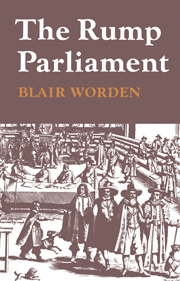Book contents
- Frontmatter
- Contents
- Dedication
- Acknowledgements
- Author's Note
- List of abbreviations
- Introduction
- PART ONE THE RUMP AND THE RUMPERS
- PART TWO THE RUMP AND REFORM
- PART THREE THE STRUGGLE FOR SURVIVAL, FEBRUARY 1649–SEPTEMBER 1651
- PART FOUR PARLIAMENT versus THE ARMY, SEPTEMBER 1651–APRIL 1653
- 13 Reform and reaction, September 1651–May 1652
- 14 Conflict and confrontation, May–December 1652
- 15 Dissolution and disarray, January–April 1653
- PART FIVE THE DISSOLUTION OF THE RUMP
- APPENDICES
- Bibliographical Guide
- Index
15 - Dissolution and disarray, January–April 1653
Published online by Cambridge University Press: 29 January 2010
- Frontmatter
- Contents
- Dedication
- Acknowledgements
- Author's Note
- List of abbreviations
- Introduction
- PART ONE THE RUMP AND THE RUMPERS
- PART TWO THE RUMP AND REFORM
- PART THREE THE STRUGGLE FOR SURVIVAL, FEBRUARY 1649–SEPTEMBER 1651
- PART FOUR PARLIAMENT versus THE ARMY, SEPTEMBER 1651–APRIL 1653
- 13 Reform and reaction, September 1651–May 1652
- 14 Conflict and confrontation, May–December 1652
- 15 Dissolution and disarray, January–April 1653
- PART FIVE THE DISSOLUTION OF THE RUMP
- APPENDICES
- Bibliographical Guide
- Index
Summary
Army pressure on the House escalated dramatically at the turn of the year. On 1 January an army writer reported that ‘the officers have been seeking God two days; the grandees fear a design in hand’. Cromwell had a meeting with the Council of Officers on 5 January, when, after extensive debate, a sub-committee was appointed to ‘draw up the sense of the council concerning the constituency of the civil authority by successive parliaments, and the just and equal dispensation of justice through the nation for the greatest ease and advantage of the people and concerning matters of religion’. The sub-committee took some time to report, and when the officers met again on 20 January there were signs of division among them. They decided to send a circular to the regiments in England, Scotland and Ireland to enlist their support, but ‘could not at present agree’ about the document's contents. On the 21st some of the gathered churches of London tried to present the officers with a ‘paper of advice’, but their offer was refused. The less radical of the officers, Cromwell no doubt among them, seem to have been making a stand against their more extreme colleagues; but by the 28th, after the army leaders had spent ‘several days waiting at the throne of grace’, the circular was ready. Forceful demands were also made for law reform, religious toleration and the propagation of the gospel. The document was not as outspoken as the Rump must have feared, but it marked a systematic attempt to coordinate army discontent.
- Type
- Chapter
- Information
- The Rump Parliament 1648–53 , pp. 317 - 342Publisher: Cambridge University PressPrint publication year: 1974

